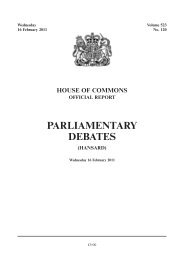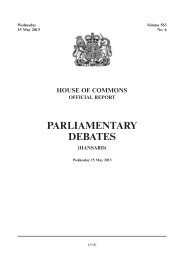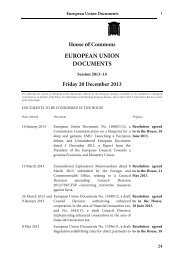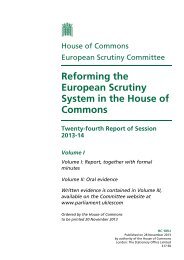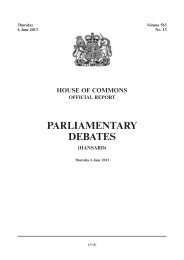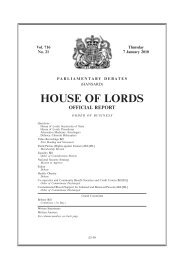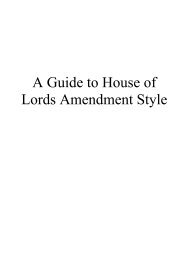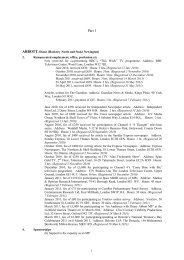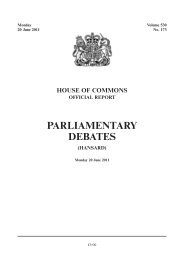here - United Kingdom Parliament
here - United Kingdom Parliament
here - United Kingdom Parliament
You also want an ePaper? Increase the reach of your titles
YUMPU automatically turns print PDFs into web optimized ePapers that Google loves.
899 National Policy Statements 1 DECEMBER 2010 National Policy Statements 900<br />
[Charles Hendry]<br />
policy statement or to introduce one specifically for<br />
marine technologies. In this country, we have a network<br />
of rivers, which are a potential source for electricity<br />
generation that we are keen to see harnessed.<br />
Ian Swales (Redcar) (LD): The Minister has discussed<br />
the urgent need for new renewable electricity generation<br />
capacity. If that is the case, why is the banding review of<br />
renewables not reporting until August 2012 with<br />
implementation in March 2013? Will he consider speeding<br />
up that process, so that we can get the capital that is<br />
waiting for, for example, biomass power stations released<br />
and get such projects under way?<br />
Charles Hendry: One of the issues for investors in this<br />
area is certainty. They want to be able to plan for the<br />
long term and to know what rate of support they will<br />
get under whatever mechanism is in place. A date of<br />
2013 enables people to plan a transition to whatever the<br />
banded level will be after that. I understand the need for<br />
early clarity, and if t<strong>here</strong> are ways we can provide that,<br />
we shall seek to do so. We seek to work constructively<br />
because we understand that the alternative can be a<br />
hiatus in investment, with investment dropping off for a<br />
period of years in advance of the threshold and the<br />
level of support changing. It is important, in terms of<br />
national interest, to have a continuous flow of investment.<br />
I turn now to the issues that have been covered in the<br />
energy national policy statements. Perhaps it would be<br />
helpful if I briefly set out the purpose of the documents<br />
before us today. The revised draft energy national policy<br />
statements consist of a suite of six national policy<br />
statements and a number of associated documents.<br />
They are not intended to set out new energy policy.<br />
They are consistent with and explain current energy<br />
policy and how it relates to the planning consent process.<br />
Similarly, we are not using national policy statements to<br />
change the standard for consenting projects. They neither<br />
raise nor lower the bar on how a major energy infrastructure<br />
project is examined and consented. They are t<strong>here</strong> to<br />
explain how such decisions should be made. They set<br />
out the consenting policies that need to be considered in<br />
the examination of major energy infrastructure and the<br />
decision on whether to grant or decline consent. At the<br />
same time, they will ensure that new major energy<br />
infrastructure projects respect the principles of sustainable<br />
development. They will allow not only the Infrastructure<br />
Planning Commission but developers and local residents<br />
to see the basis on which applications must be considered.<br />
T<strong>here</strong> is an overarching energy national policy statement<br />
that sets out the Government’s policy on energy and<br />
energy infrastructure development; an energy need<br />
statement on the need for new nationally significant<br />
energy infrastructure projects; the assessment principles<br />
that need to be taken into account in examining and<br />
deciding on proposals for energy infrastructure<br />
development; and generic impacts for all energy<br />
infrastructure, and how they should be assessed and<br />
mitigated to ensure that the right balance is reached<br />
between securing our energy needs and protecting the<br />
environment.<br />
T<strong>here</strong> are also five technology-specific energy national<br />
policy statements, covering fossil fuel electricity generation;<br />
renewable energy infrastructure, which deals with onshore<br />
wind, offshore wind and energy from biomass and/or<br />
waste; gas supply infrastructure and gas and oil pipelines;<br />
electricity networks infrastructure; and nuclear power<br />
generation.<br />
David Morris (Morecambe and Lunesdale) (Con):<br />
We know that we are legally required to reduce carbon<br />
emissions by about 80% in the next 40 years. Can we<br />
fulfil that requirement, given that of the 59 GW of new<br />
capacity required in the next 25 years, 33 GW of which<br />
is needed from renewables, we have only 2 GW currently<br />
under construction? The other 26 GW that is needed<br />
will, presumably, come from low-carbon nuclear. The<br />
Government have made enormous progress in this area—I<br />
acknowledge that—but would t<strong>here</strong> be more scope to<br />
look at nuclear if we, for whatever reason, did not hit<br />
those targets?<br />
Charles Hendry: I pay tribute to the work that my<br />
hon. Friend has done as an ardent supporter of the<br />
Heysham plant in his constituency and of the case for a<br />
new plant in that area. The role for nuclear has been set<br />
out clearly in the national policy statements. We believe<br />
that it has a fundamental role, but we also have to be<br />
realistic about what is achievable. We have identified<br />
sites that could be used for 16 GW of new nuclear<br />
power, but that is as much as the energy companies<br />
believe can be constructed over the next 15 years, which<br />
is the time scale that the national policy statements<br />
cover. That is not necessarily the end of the ambition,<br />
but it looks like what is achievable and realisable over<br />
those 15 years. T<strong>here</strong> is no doubt about the Government’s<br />
ambition in terms of new nuclear.<br />
Martin Horwood: On the subject of what is realistic,<br />
and referring back to what the Minister was saying<br />
about sustainability, is he aware that the Chartered<br />
Institution of Water and Environmental Management<br />
has said that current known reserves of economically<br />
extractable uranium may last only between 40 and<br />
85 years? Given that other economies are also investing<br />
in new nuclear, we may be looking at the lower end of<br />
that scale rather than the higher, so new nuclear cannot<br />
be regarded as sustainable in any real sense.<br />
Charles Hendry: I have certainly heard that point<br />
before. The OECD has a fundamentally different view<br />
of the availability of uranium stocks, and t<strong>here</strong> is work<br />
to be done in plutonium reprocessing, which would<br />
provide an additional source of fuel. Furthermore, work<br />
is being done on the development of thorium reactors,<br />
which do not give rise to many of the concerns that<br />
people have about uranium reactors. A great deal of<br />
progress can be made and, at the end of the day, the<br />
decision is for investors to make. If they do not believe<br />
that t<strong>here</strong> is sufficient uranium to power their plants for<br />
their lifetime, they will not make that investment. They<br />
will base their decision on the facts available to them<br />
and they will need to be reassured about the availability<br />
of stocks.<br />
The overarching national policy statement contains<br />
information on the impacts that need to be considered<br />
for all energy infrastructure, while the technology-specific<br />
NPSs contain additional information on the impacts<br />
that are specific to each technology. They take into<br />
account the appraisals of sustainability. We have revised<br />
the AOSs for the non-nuclear NPSs substantially, which<br />
is why we are a carrying out a fresh consultation.



